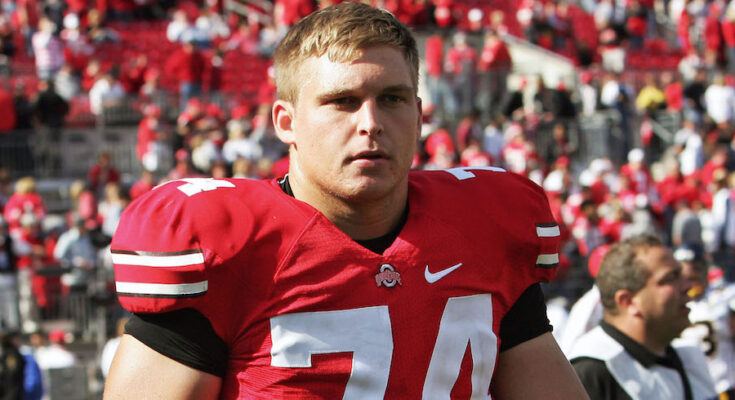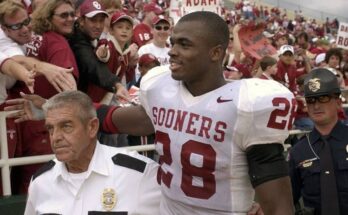Former Ohio State offensive lineman Kirk Barton has been formally charged with aggravated vehicular manslaughter following a deadly car crash that occurred in Dublin, Ohio.
Former Ohio State offensive lineman Kirk Barton, once known for his powerful presence on the football field and leadership as a team captain, now finds himself at the center of a deeply tragic and legally complex situation. Authorities in Dublin, Ohio have charged Barton with aggravated vehicular manslaughter following a fatal car crash that has left a community in mourning and raised serious questions about accountability, decision-making, and the far-reaching consequences of one moment of catastrophe.
The incident in question took place in the suburban city of Dublin, a community located just northwest of Columbus. Known for its affluence, good schools, and quiet neighborhoods, Dublin is not often the site of violent or deadly collisions. That changed when law enforcement officials responded to the scene of a high-impact crash that resulted in the death of another motorist. According to initial reports and statements released by investigators, Barton was identified as the driver of one of the vehicles involved in the collision. Following a preliminary investigation, he was arrested and charged with aggravated vehicular manslaughter, a serious felony under Ohio law that carries the potential for significant prison time if convicted.
Barton’s history with Ohio State stretches back nearly two decades. A standout offensive lineman for the Buckeyes, Barton was part of a dominant stretch for the program in the early 2000s. He earned All-Big Ten honors and was a team captain under head coach Jim Tressel, remembered for his toughness, technique, and football IQ. After his college career, Barton was drafted into the NFL, though his professional football career was relatively short-lived. He later returned to Ohio State in various unofficial capacities, maintaining close ties with the program and its alumni base.
News of his arrest has sent shockwaves through Buckeye Nation. For fans who remember Barton’s contributions on the field, it’s a difficult reality to reconcile. He was, at one point, a model of the kind of grit and perseverance that Ohio State football has long celebrated. Now, he’s facing a future that could include a lengthy prison sentence, the loss of his freedom, and permanent damage to his public reputation.
What makes the situation all the more tragic is the fact that someone has lost their life. While the identity of the victim has not yet been publicly released, family members and friends are grieving the sudden and violent loss of a loved one. For them, this is not a headline or a legal case—it’s a devastating, life-altering moment. In court filings and early statements from the prosecution, it’s been made clear that the crash was severe, and the victim likely died at the scene or shortly thereafter due to blunt-force trauma caused by the impact.
Aggravated vehicular manslaughter, under Ohio’s criminal code, is typically charged when a person causes the death of another while operating a vehicle under the influence of alcohol or drugs, or through reckless driving. Though the full scope of evidence has not yet been released, prosecutors appear confident in their ability to prove that Barton’s actions met the threshold for such a charge. Toxicology results, eyewitness statements, and vehicle telemetry data are all expected to play a role in the coming legal proceedings. If it is found that Barton was impaired at the time of the crash, the charges could be even more severe and the penalties harsher.
For those who know Barton personally, the news has come as a shock. Former teammates, coaches, and friends have expressed disbelief and sorrow, with many reserving judgment until more details become available. Still, even the most supportive voices cannot overlook the fact that a life has been lost. Sympathy for Barton, while understandable on a human level, is tempered by the gravity of the circumstances and the irreversible nature of the consequences.
This case is likely to unfold slowly, as is typical with felony charges involving death and extensive investigations. Barton has retained legal counsel, and early indications suggest he plans to fight the charges. His legal team may argue that the crash was an accident and not the result of gross negligence or impairment. They may question the accuracy of police reports, challenge the admissibility of certain evidence, or attempt to negotiate a plea deal that could reduce the severity of the charges in exchange for a guilty plea to a lesser offense. All of these possibilities remain speculative until official court proceedings begin in earnest.
The emotional weight of this case will also be significant. In similar cases across the country, victims’ families often attend every hearing, hoping for justice, closure, or at the very least, acknowledgment of their loss. Statements read in court can be powerful and heartbreaking, offering a glimpse into the human cost of fatal accidents that statistics and charges often fail to capture.
In the world of college football, where former players are often elevated to near-mythical status and revered long after their playing days are over, this case serves as a grim reminder of the reality that even those once held up as heroes are human beings capable of making mistakes—sometimes with catastrophic results. The Ohio State community, while fiercely loyal to its own, also understands the importance of accountability and the sanctity of life. As the facts continue to emerge, many will watch this case closely—not just for its legal outcome, but for what it says about responsibility, redemption, and the potential for healing in the aftermath of loss.
Barton’s story is one that now straddles two very different narratives. On one hand, he is remembered as a tough, reliable force on one of college football’s most iconic teams. On the other, he now stands accused of a crime that took another person’s life. These two versions of Barton—the athlete and the defendant—are now inextricably linked, and how this chapter unfolds may forever redefine how he is remembered.
Public reaction has been predictably intense. Social media platforms quickly lit up with news of the charges, with opinions ranging from shock and sorrow to anger and demands for justice. Some fans, unable to reconcile Barton’s past achievements with the present allegations, expressed disbelief and called for due process. Others, particularly those who empathize with the victim’s family, voiced frustration and heartache. In high-profile cases involving former athletes, these divides are common, often reflecting broader conversations about celebrity, accountability, and the justice system’s role in cases involving public figures.
Beyond the immediate tragedy and legal implications, this case also brings attention to larger issues regarding driver safety, impaired driving, and the lasting impact of split-second decisions. Across the United States, fatal car accidents remain a leading cause of death, and too often, those deaths are preventable. Whether through stricter enforcement of impaired driving laws, increased public awareness campaigns, or better vehicle safety technology, society continues to grapple with how to reduce these numbers. In some instances, high-profile cases like Barton’s can spur dialogue and legislative change, though the effectiveness of such changes often varies.
It remains to be seen whether Barton will issue a public statement about the crash or the charges. His legal team may advise against it to avoid self-incrimination or to maintain control of the narrative in court. Still, in cases like this, a statement of remorse—even if legally constrained—can sometimes go a long way toward acknowledging the pain caused and demonstrating a willingness to accept some level of responsibility.
As of now, Barton is expected to appear before a judge for an arraignment, during which he will formally hear the charges against him and enter a plea. From there, pre-trial motions, discovery, and potentially a jury trial could follow. It is a long road ahead for everyone involved—the victim’s family, who must relive the trauma in courtrooms and media coverage, and Barton himself, who must confront the legal and moral weight of his actions.
In the end, the most enduring truth in this case is the loss of life—a fact that no amount of legal maneuvering, football accolades, or public sympathy can change. A family is grieving. A life has ended too soon. And a former Ohio State football star is now facing the most serious challenge of his life, one that will ultimately be measured not in yards gained or blocks made, but in the ability of the legal system—and perhaps the human spirit—to find justice and meaning amid sorrow.



